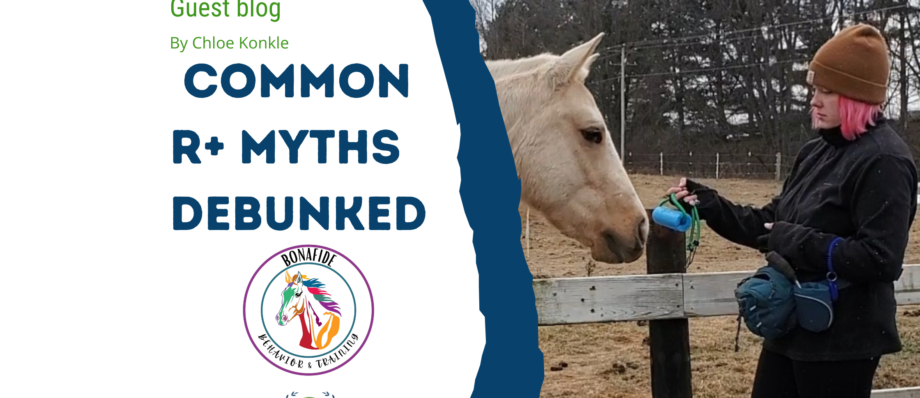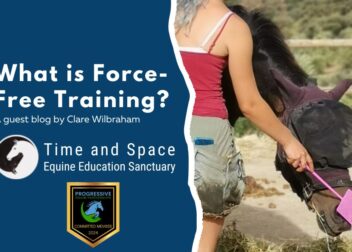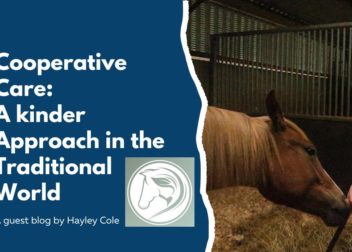Common r+ myths debunked
Guest blog by: Chloe Konkle of Bonafide Behaviour and Training
Below are the most common myths I’ve heard throughout my R+ journey. I’ll be honest, having a strong foundation in traditional training myself, I’ve had these thoughts too. I chose to let them go and continue learning. I’m so glad I did.
Myth 1
“My horse needs to respect me as the lead horse. I need to be dominant and a strong leader.”
Equine social systems do not contain “dominance” in the way we typically hear the word used. Because of the size of the equine frontal lobe, we know that horse’s are incapable of generalizing and rationalizing in the way that we are- they are incapable of acting out of spite or understanding the concept of “respect.” Horses do what works, whether that be seeking the appetitive or avoiding the aversive, both in the context of training, in their day-to-day lives, and horse-horse social interactions.
Dominance exists between group-living animals and dictates priority of access to resources, meaning horse-human relationships and interactions are incapable of having dominant/submissive roles, behaviors and communication. Dominance-based behaviors are peaceful and quick to resolve conflict; in an appropriately managed and set-up environment, you may notice a hip swing, pinned ears, a stretched out neck and/or conflict avoidance behaviors like averting their gaze or moving away and usually no further escalation in aggression.
Giles, Sarah L., et al. “Dominance Rank Is Associated with Body Condition in Outdoor-Living Domestic Horses (Equus Caballus).” Applied Animal Behaviour Science, Elsevier, 18 Mar. 2015 https://www.sciencedirect.com/science/article/pii/S0168159115000672https://www.sciencedirect.com/science/article/pii/S0168159115000672
Hartmann, Elke, et al. “Dominance and Leadership: Useful Concepts in Human–Horse Interactions?” Journal of Equine Veterinary Science, W.B. Saunders, 6 Feb. 2017 https://www.sciencedirect.com/science/article/pii/S0737080617300059https://www.sciencedirect.com/science/article/pii/S0737080617300059
Henshall, Cathrynne, et al. The Radio-Controlled Car as a Herd Leader? A Preliminary Study of Escape and Avoidance Learning Jan. 2012 https://www.researchgate.net/publication/289530907_The_radio-controlled_car_as_a_herd_leader_A_preliminary_study_of_escape_and_avoidance_learning_in_the_roundpen
With the information from these studies, we can conclude that requiring a horse to walk at your side (or behind) or making them “move their feet,” as a means of “asserting our dominance” simply doesn’t make sense to our equine partners. Horse’s behaviors are a result of reinforcement and punishment rather than respect or the ability of their handler “speaking their language”. Anthropomorphic views of horse behavior can jeopardize the welfare of our learner and the safety of the people in their lives.
Myth 2
“Clicker training will make my horse fat.”
Arguably, this one could be fact if you’re feeding sugary treats, apples, carrots, and the like however, any positive-reinforcement based behavior consultant, instructor, or trainer will recommend you use forage as the main reinforcement. This could be timothy pellets, alfalfa pellets, hand-picked grass, or even their normal hay. Horses are foragers and their bodies are built to have access to food 24/7; taking them off pasture to feed another forage-based food, they won’t really be getting any “extra” food!
Ps. Yes, you can use sugary treats- just sparingly! Reserve them for “jackpot” rewards, challenging behaviors, or potentially scary situations (vet visits, hoof trims, getting in the trailer, etc)
Myth 3
“I tried R+ and it didn’t work/my horse didn’t like it. You can’t train a horse ‘like a dog’.”
R+ is growing among all species and isn’t only for dogs! Many recognized positive reinforcement based trainers started out in zoos and aquariums working with exotic animals. It’s amazing to see many people adopting R+ as their preferred method when working with animals and the results are undeniable.
Lion Target Training & Husbandry- https://youtu.be/fTnIL_MABAEGiraffe
Hoof Care- https://youtu.be/jIJDhtnKYs
Dolphin Husbandry- https://youtu.be/4_L0y0jLJm8
Gibbon Tuberculosis Test- https://youtu.be/LSUACcbHYRo
Crate Training Lemurs- https://www.youtube.com/watch?v=Ef1a9gJDFbg
If we can train all these animals through positive reinforcement, there’s no reason we can’t do the same with our horses. If they can eat and think- positive reinforcement works! By definition positive reinforcement is adding something appetitive (pleasant) to increase the likelihood of a behavior being repeated, if the behavior is not being repeated, what you offered may not have actually been reinforcing. A common issue when starting out with R+ is that our skills aren’t great. Just like traditional training, it takes practice to be a good trainer; you may be too late on your clicks, offering a food reward your horse doesn’t like, asking for too much too quickly, not breaking things down enough, or maybe the horse isn’t feeling well emotionally or physically.
Myth 4
“I can’t ride without traditional training.”
Riding is absolutely possible with R+ so long as the horse is physically and emotionally sound, however it might look different. You won’t be able to break a horse within a couple weeks and then trailer up to a trail and ride for hours, it takes time.
With time and practice, you can reduce how often your click and treat your horse; we can add duration to behaviors so that we no longer have to stop and feed treats every 5 seconds. Another thing we can do is teach the horse to graze after a click undersaddle! Many R+ focused trainers and owners choose to mimic traditional ridden commands, ex. using light rein pressure for directional cues or stopping, clucking or kissing to cue the horse to go faster. We can train these things from the ground using no pressure at all or light, non-escalating pressure. The possibilities are really endless!
Myth 5
“My horse must understand how to give to pressure for their safety as well as my own.”
I believe that horses should be able to participate in regular care and management practices. We currently live in a traditional training centric world. It’s not possible in most circumstances to completely avoid R- in our horse’s day to day life. However we should be implementing these practices in a minimally stressful way by using R+ as much as possible. For example, we can use cooperative care to encourage our horses to participate in husbandry behaviors. We can use targeting to move horse from stall to pasture or pasture to trailer. We can train horses to station on a mat to get their feed, be tacked up, or groomed. Following the humane hierarchy, we should be reserving aversive methods for emergencies or when we’ve exhausted all other approaches. Positive reinforcement has been proven more effective!
Scott HK, Jain A, Cogburn M. Behavior Modification. 2021 Nov 21. In: StatPearls [Internet]. Treasure Island (FL): StatPearls Publishing; 2022 Jan https://pubmed.ncbi.nlm.nih.gov/29083709/#:~:text=Reinforcement%20and%20punishment%20both%20work,better%20and%20faster%20than%20punishment.
Barrett, Amy. “Reward, Not Punishment, Is the Key to a Happy, Well-Trained Dog.” BBC Science Focus Magazine, 17 Dec. 2020 https://www.sciencefocus.com/news/reward-not-punishment-is-the-key-to-a-happy-well-trained-dog/
By: Chloe Konkle of Bonafied behavior and training.
Online (email/video review) consultations for those looking to explore positive reinforcement. Bonafide uses modern training based on science. Head over to the website to see details of services offered and to shop for clickers, targets, pouches and treats.
Knowing how horses learn will help you better understand different training methods so that you can feel confident in choosing methods that best suit your individual partnership.
Progressive Equine Partnerships offers an online learning course (equine learning theory) for just £20.




